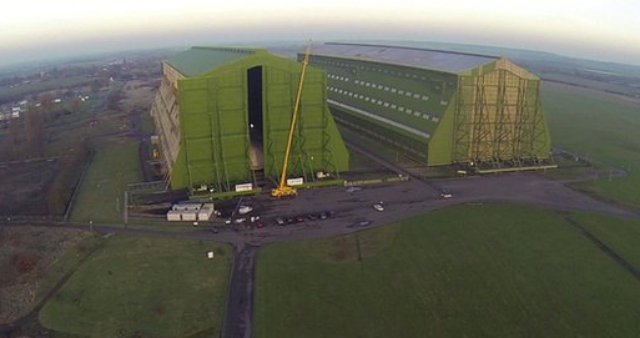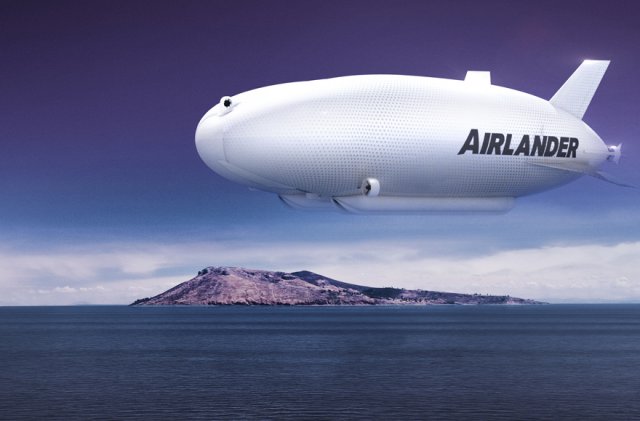A 300-foot-long aircraft originally developed for, by then dropped by, the US Army was recently re-unveiled in Great Britain as the world’s largest aircraft. The HAV 304 “Airlander” is an amalgamation of airship, airplane, helicopter and hovercraft features, and is referred to as a hybrid air vehicle.
While the aircraft most closely resembles an airship, or dirigible, and is filled with helium, the shape of the balloon allows the vehicle to generate lift. It is expected to be able to stay aloft for three weeks and carry up to 22,000 pounds of cargo.
The entire aerostat, a terms that encompasses all tethered and free flying lighter than air craft, can also be piloted remotely, making it the largest unmanned aerial vehicle as well.
Hybrid Air Vehicles, based in Cardington, England, sees the utility of the vehicle in terms of its operational flexibility. The Airlander will be able to conduct conventional take-off and landing and vertical take-off and landing on both land and water. In the future, the blimp may be used to deliver humanitarian aid, provide communications, broadcast sporting events and conduct surveillance missions.
Development of the aircraft began as a U.S. Army project, and a surveillance configuration is one of two available options for the Airlander, the other being a civil heavy lift version. The surveillance vehicle can operate at up to 16,000 feet for up to five days as a manned vehicle.
In 2010, Northrop Grumman and HAV partnered to develop the Long Endurance Multi-Intelligence Vehicle (LEMV) for the Army, but the programme was plagued by technical and performance challenges and eventually was discontinued due to budget issues. The blimp was sold back to HAV for a mere $301,000, a fraction of the development cost.
HAV has now received £2.5m of government funding to develop the technology and engineering for the project.
“We are jointly funding £2bn of research and development into the next generation of quieter, more energy efficient and environmentally friendly planes,” says Business Secretary Vince Cable. “That includes backing projects like Hybrid Air Vehicles’ innovative low carbon aircraft which can keep us at the cutting edge of new technology. Here is a British SME that has the potential to lead the world in its field.”
 All of which will be welcome news to one of the project’s high-profile investors, Bruce Dickinson. He is one of those people who can’t stop achieving stuff. As if being the lead singer of one of the world’s most successful and enduring rock bands, Iron Maiden, was not enough, he is also an airline pilot, businessman, and is investing in this project. “It’s a game changer, in terms of things we can have in the air and things we can do,” he says. “The airship has always been with us, it’s just been waiting for the technology to catch up.” He wants to sell them and he’ll be very good at it. As we chat in the hangar, he goes through its credentials. It is 70% greener than a cargo plane, he says. It doesn’t need a runway, just two crew. And it can plonk 50 tonnes anywhere in the world you like, which is 50 times more than a helicopter.
All of which will be welcome news to one of the project’s high-profile investors, Bruce Dickinson. He is one of those people who can’t stop achieving stuff. As if being the lead singer of one of the world’s most successful and enduring rock bands, Iron Maiden, was not enough, he is also an airline pilot, businessman, and is investing in this project. “It’s a game changer, in terms of things we can have in the air and things we can do,” he says. “The airship has always been with us, it’s just been waiting for the technology to catch up.” He wants to sell them and he’ll be very good at it. As we chat in the hangar, he goes through its credentials. It is 70% greener than a cargo plane, he says. It doesn’t need a runway, just two crew. And it can plonk 50 tonnes anywhere in the world you like, which is 50 times more than a helicopter.
He wants to drum up publicity with the kind of trip Richard Branson would dream up. A non-stop flight around the world – twice. “It seizes my imagination. I want to get in this thing and fly it pole to pole,” he says. “We’ll fly over the Amazon at 20ft, over some of the world’s greatest cities and stream the whole thing on the internet.”
Historic hangars
 It is not surprising that we had to go to Britain’s biggest aircraft hangar to see the world’s longest aircraft. Cardington shed number one, in Bedfordshire, is nearly as impressive as the flying machine inside it. Built 100 years ago, it dominates the skyline around here (along with its neighbour Cardington number two shed) and it is bristling with history. This is where they built the ill-fated airship, R101, back in the 1920s.
It is not surprising that we had to go to Britain’s biggest aircraft hangar to see the world’s longest aircraft. Cardington shed number one, in Bedfordshire, is nearly as impressive as the flying machine inside it. Built 100 years ago, it dominates the skyline around here (along with its neighbour Cardington number two shed) and it is bristling with history. This is where they built the ill-fated airship, R101, back in the 1920s.That behemoth was twice as long as the hybrid air vehicle, had a beautiful dining room and lounge on board, and was meant to herald the future of flight, right up until the moment it was devoured by fire after a crash in France in 1930. Technology has come a long way since then. The Hybrid Air Vehicle (HAV) is full of inert helium, not explosive hydrogen.
Sources: BBC News, Defense Systems

